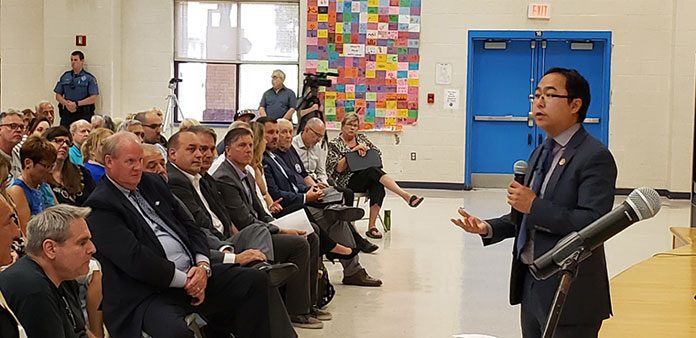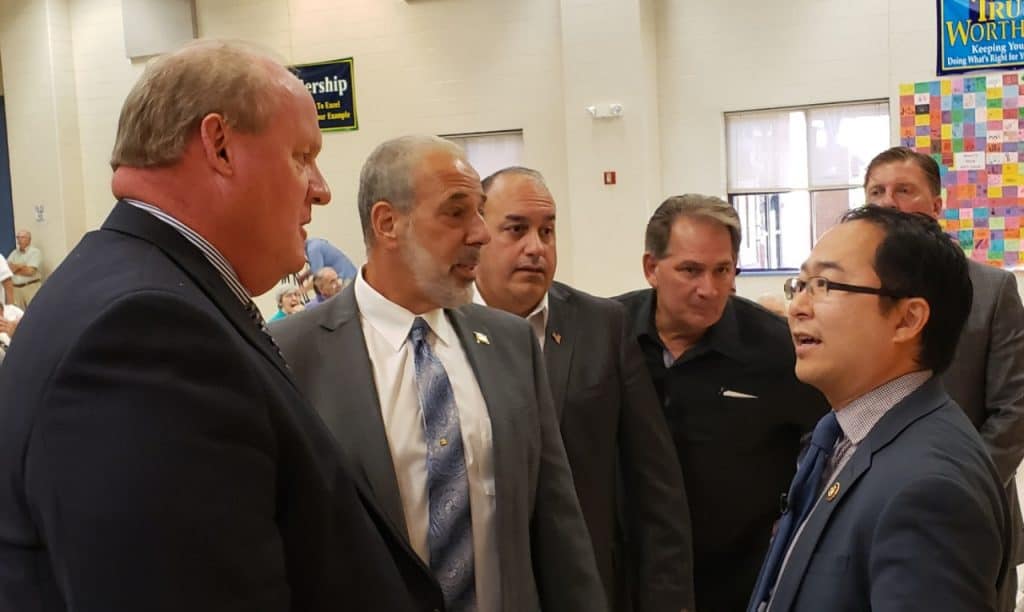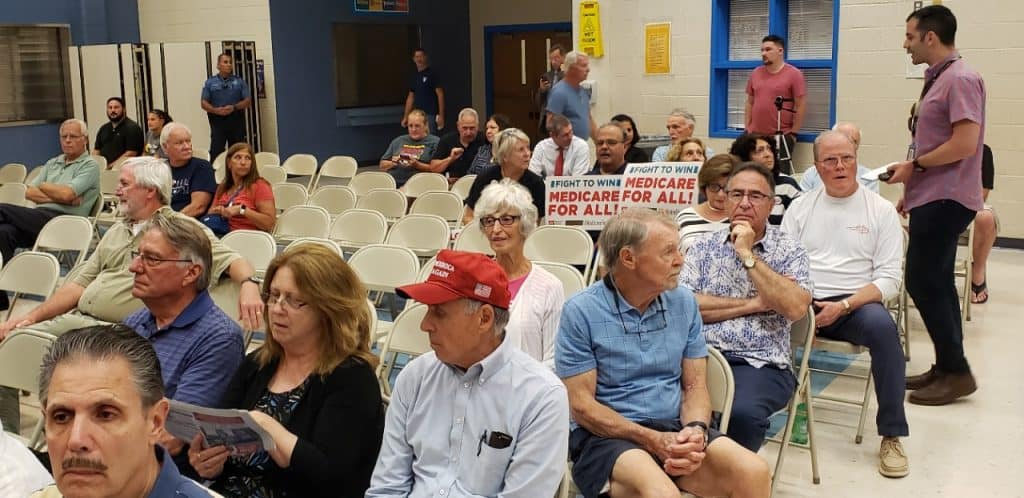
LACEY – The decommissioning of the Oyster Creek Generating Station dominated the last of three town hall meetings that Congressman Andy Kim (D-3rd) held this summer.
Kim’s last meeting was held recently at the Lacey Middle School. Around 150 people, the majority of which were Lacey residents, came to the school’s gymnasium to hear details of the nuclear power plant’s decommissioning status.
Attendees expressed concerns about the plant’s decommissioning process noting safety, cost, and public involvement. Oyster Creek was the oldest operating nuclear power plant in the country when it closed in September 2018. Holtec International, based in Camden, purchased the facility earlier this year from Exelon Generation of Chicago.
Holtec will decommission the 50-year-old facility that will profit off the reactor’s nearly $1 billion decommissioning trust fund, which is money set aside for dismantling the reactor.
Removing Radioactive Material
Originally, Exelon had planned to dismantle the plant over a 60-year period, a process that would have allowed some of the facility’s radioactivity to degrade to safer levels. Holtec’s proposal seeks to complete the decommissioning within a decade. That was a sticking point expressed by several attendees who questioned Holtec’s ability to accomplish this in a shorter time span.

Marianne Clemente, Barnegat, asked “how did it get from 60 years to six years? What miracle technology was developed?” Other residents voiced concern about how casks of radioactive material would be safely transported off the premises.
Jeffrey Dostal, former plant manager of Oyster Creek, said he is overseeing the plant’s dismantling as an employee of Holtec and that he would be working with other former Exelon employees of Oyster Creek. “My family and I live in this area. I would not put them in harm’s way.” He pledged state of the art technology and materials would be used during the process.
Dostal added that no demolition of buildings at the plant would occur until after radioactive material was put into storage. The timetable for that is November 2021.
Representatives from the U.S. Nuclear Regulatory Commission were also in attendance at the meeting to answer questions and address points from a letter that Kim sent to NRC Chairwoman Kristine L. Svinicki on July 11. That letter included eight questions focusing on concerns by residents who felt the NRC had not responded to their questions about decommissioning the plant.
Kim requested a written response from the NRC by Aug. 9. His office received a response by Svinicki dated Aug. 16 addressing each question. When asked whether he was satisfied with the response to his letter, Kim said, “No, there is more here that needs to learned which is why the NRC came out today to hear the tone of the public’s concern.”
He added that “this meeting is just the beginning of a process of informing the public of what is being planned.” A meeting to include Holtec representatives will be held on Sept. 23 at the same location to delve further into the process.
Decommissioning Costs
Kim asked in his letter that in the event that the cost of the plant’s decommissioning was less than the amount currently sitting in the decommissioning trust fund, would those leftover funds be returned to the taxpayer or would they be left with Holtec International?
Svinicki wrote “once a licensee has completed radiological decommissioning and the NRC has terminated the operating license, the agency no longer has jurisdiction over the decommissioning trust fund. At that time, the disposition of any remaining trust funds would be the responsibility of the former licensee, subject to any other financial obligations it may have.”
The congressman had also asked that in the event that the cost of the Oyster Creek decommissioning runs over the amount in the decommissioning trust fund, would taxpayers be liable for any additional costs stemming from this process?
Svinicki’s response was that “at all times the licensee has full responsibility to provide adequate funding for all NRC-required decommissioning activities.” She added that during the decommissioning process her agency would oversee Holtec’s decommissioning including its funding. “NRC regulations require a licensee to submit a site-specific decommissioning cost estimate that encompasses all costs required to decommission the plant.”
Lacey Councilman Peter Curatolo said after the meeting that he was confident that Lacey residents would not be “left holding the bag.” He said he had verified with Dostal that “in the remote event that the decommissioning fund is depleted, Holtec is the responsible party until such time the decommissioning is completed to NRC standards. I want Lacey residents assured that these safety measures and regulations are in place to protect their physical and financial well-being.”
Svinicki wrote to Kim that “NRC regulations require a licensee to submit a site-specific decommissioning cost estimate that encompasses all costs for completing radiological decommissioning.”
She added that after a plant permanently closes and until radiological decommissioning is completed, “a licensee is required to submit decommissioning funding status reports each year and certify that sufficient financial assurance for decommissioning has been provided.”

Safety Concerns
Regarding the congressman’s question of whether there was any environmental impact study done at Oyster Creek prior to the license transfer and if the NRC or Holtec planned to conduct one, Svinicki wrote that the “last environmental impact statement (EIS) prepared for Oyster Creek was the Supplemental EIS issued as part of the NRC’s license renewal review in 2009.” She added that per NRC regulations, a licensee must submit a post shutdown decommissioning activities report (PSDAR) and that no environmental review was performed as part of the license transfer.”
Brick resident Janet Tauro, the Board Chair for Clean Water Action questioned the stability of the casks that contain radioactive material. This was also one of Kim’s questions which Svinicki responded to saying NRC staff “performs inspections at the cask fabricators’ facilities to ensure that regulatory requirements are met during the design and production phases.” She added that routine safety inspections are performed every two years.
Kim included in his letter that “over the course of the life of the Spent Nuclear Fuel (SNF) at Oyster Creek, will Holtec be responsible for the long-term safety and repair of casks and what are the best practices that will define Holtec’s responsibilities?”
Svinicki responded, “yes, Holtec is responsible for the safety of the casks and any necessary repairs for as long as it is the license holder.”
Forming A Community Advisory Group
The subject of establishing a citizens advisory group was another hot button issue discussed at the meeting. Kim had asked about this in his letter. Svinicki responded saying, that to date, the NRC had not been informed of any plans to form such an entity. “The NRC encourages licensees to sponsor community advisory boards for decommissioning.”
Lacey Mayor Timothy McDonald said during the meeting that “we had a good relationship with Exelon and we want to see the concerns of Lacey are heard. We want to see the process put together for this very carefully.”
“The process of how this plant is decommissioned must be transparent. These are big complicated issues and you are right to be concerned,” Kim said.
Members of the group Concerned Citizens of Lacey spoke up saying they would like to see a citizen’s advisory group formed immediately.
Oyster Creek however was not the only topic some attendees wanted discussed. A few area residents sat in the audience holding signs calling for Medicare for all.

Thomas Cannavo, Beachwood, is a member of the New Jersey Universal Health Care Coalition. “I would like to see Congressman Kim co-sponsor HR 1384, the Medicare for All Act of 2019. The majority of Democrats in the House have signed on, 118. We need a single payer system which covers everyone from cradle to grave.”
This meeting marked Kim’s eleventh Town Hall during the 116th Congress, and part of a monthly series to allow him to hear directly from constituents throughout New Jersey’s Third District.






